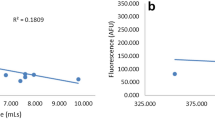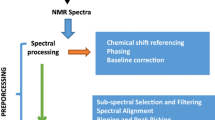Abstract
Metabolite profiling of urine has seen much advancement in recent years, and its analysis by nuclear magnetic resonance (NMR) spectroscopy has become well established. However, the highly variable nature of human urine still requires improved protocols despite some standardization. In particular, diseases such as kidney disease can have a profound effect on the composition of urine and generate a highly diverse sample set for clinical studies. Large variations in pH and the cationic concentration of urine play an important role in creating positional noise within datasets generated from NMR. We demonstrate positional noise to be a confounding variable for multivariate statistical tools such as statistical total correlation spectroscopy (STOCSY), thereby hindering the process of biomarker discovery. We present a two-dimensional buffering system using potassium fluoride (KF) and phosphate buffer to reduce positional noise in metabolomic data generated from urine samples with various levels of proteinuria. KF reduces positional noise in citrate peaks, by decreasing the mean relative standard deviation (RSD) from 0.17 to 0.09. By reducing positional noise with KF, STOCSY analysis of citrate peaks saw significant improvement. We further aligned spectral data using a recursive segment-wise peak alignment (RSPA) method, which leads to further improvement of the positional noise (RSD = 0.06). These results were validated using diverse selection of metabolites which lead to an overall improvement in positional noise using the suggested protocol. In summary, we provide an improved workflow for urine metabolite biomarker discovery to achieve higher data quality for better pathophysiological understanding of human diseases.

Citrate peaks in the range 2.75–2.5 ppm from datasets with different sample preparation protocols and with/without in silico alignment. A Citrate peaks with standard phosphate buffering and without in silico alignment. B citrate peaks with standard phosphate buffering and with in silico alignment. C citrate peak with additional potassium fluoride and standard phosphate buffering without in silico alignment. D citrate peaks with additional potassium fluoride and standard phosphate buffering with in silico alignment. Below the respective spectrum are displayed the percent relative standard deviation (RSD) of the respective citrate peaks. This is a measure of the positional noise of peaks within a 1H NMR analysis. It can be seen that D performs the best in reducing positional noise of citrate peaks. E–H STOCSY analysis of correlating spectral features with the driver peak at 2.675 ppm (see red arrow) to identify structural correlations. As a, b, c, and d are known to be structurally correlated, STOCSY analysis should reveal r 2 = 1 if data is perfectly aligned and can therefore be used as a measure of peak alignment. E Strong positional noise does not allow identifying the c and d peaks of the AB system to be correlated. F, G Neither in silico alignment or KF addition alone can completely improve the alignment and therefore increase the correlations. H Highly improved alignment by combining both KF addition and in silico alignment reduces positional noise and elucidates all four citrate peaks to be strongly correlated




Similar content being viewed by others
References
Alonso A, Marsal S, Julia A. Analytical methods in untargeted metabolomics: state of the art in 2015. Front Bioeng Biotechnol. 2015;3.
Weiss RH, Kim K. Metabolomics in the study of kidney diseases. Nat Rev Nephrol. 2012;8:22–33.
Wettersten HI, Weiss RH. Applications of metabolomics for kidney disease research. Organogenesis. 2013;9:11–8.
Emwas A-H, Luchinat C, Turano P, Tenori L, Roy R, Salek RM, et al. Standardizing the experimental conditions for using urine in NMR-based metabolomic studies with a particular focus on diagnostic studies: a review. Metabolomics. 2014;11:872–94.
Martin J-C, Maillot M, Mazerolles G, Verdu A, Lyan B, Migné C, et al. Can we trust untargeted metabolomics? Results of the metabo-ring initiative, a large-scale, multi-instrument inter-laboratory study. Metabolomics. 2014;11:807–21.
Heinzmann SS, Merrifield CA, Rezzi S, Kochhar S, Lindon JC, Holmes E, et al. Stability and robustness of human metabolic phenotypes in response to sequential food challenges. J Proteome Res. 2012;11:643–55.
Holmes E, Loo RL, Stamler J, Bictash M, Yap IKS, Chan Q, et al. Human metabolic phenotype diversity and its association with diet and blood pressure. Nature. 2008;453:396–400.
Dona AC, Jimenez B, Schäfer H, Humpfer E, Spraul M, Lewis MR, et al. Precision high-throughput proton NMR spectroscopy of human urine, serum, and plasma for large-scale metabolic phenotyping. Anal Chem. 2014;86:9887–94.
Teahan O, Gamble S, Holmes E, Waxman J, Nicholson JK, Bevan C, et al. Impact of analytical bias in metabonomic studies of human blood serum and plasma. Anal Chem. 2006;78:4307–18.
Bouatra S, Aziat F, Mandal R, Guo AC, Wilson MR, Knox C, et al. The human urine metabolome. PLoS One. 2013;8.
Lauridsen M, Hansen SH, Jaroszewski JW, Cornett C. Human urine as test material in 1H NMR-based metabonomics: recommendations for sample preparation and storage. Anal Chem. 2007;79:1181–6.
Xiao C, Hao F, Qin X, Wang Y, Tang H. An optimized buffer system for NMR-based urinary metabonomics with effective pH control, chemical shift consistency and dilution minimization. Analyst. 2009;134:916–25.
Jiang L, Huang J, Wang Y, Tang H. Eliminating the dication-induced intersample chemical-shift variations for NMR-based biofluid metabonomic analysis. Analyst. 2012;137:4209.
Veselkov KA, Lindon JC, Ebbels TMD, Crockford D, Volynkin VV, Holmes E, et al. Recursive segment-wise peak alignment of biological 1H NMR spectra for improved metabolic biomarker recovery. Anal Chem. 2009;81:56–66.
Craig A, Cloarec O, Holmes E, Nicholson JK, Lindon JC. Scaling and normalization effects in NMR spectroscopic metabonomic data sets. Anal Chem. 2006;78:2262–7.
Cloarec O, Dumas M, Craig A, Barton RH, Trygg J, Hudson J, et al. Statistical total correlation spectroscopy : an exploratory approach for latent biomarker identification from metabolic H NMR data sets statistical total correlation spectroscopy: an exploratory approach for latent biomarker identification from metabolic. Anal Chem. 2005;77:1282–9.
Bernini P, Bertini I, Luchinat C, Nincheri P, Staderini S, Turano P. Standard operating procedures for pre-analytical handling of blood and urine for metabolomic studies and biobanks. J Biomol NMR. 2011;49:231–43.
Asiago VM, Nagana GGA, Zhang S, Shanaiah N, Clark J, Raftery D. Use of EDTA to minimize ionic strength dependent frequency shifts in the 1H NMR spectra of urine. Metabolomics. 2008;4:328–36.
MacKinnon N, Ge W, Khan AP, Somashekar BS, Tripathi P, Siddiqqui J, et al. Variable reference alignment: an improved peak alignment protocol for NMR spectral data with large inter-sample variation. Anal Chem. 2012;84:5372–9.
Dieterle F, Ross A, Schlotterbeck G, Senn H. Probabilistic quotient normalization as robust method to account for dilution of complex biological mixtures. Application in 1H NMR metabonomics. Anal Chem. 2006;78:4281–90.
Acknowledgments
The research leading to these results has received funding from the European Union’s Seventh Framework Programme FP7/2007-2013 under grant agreement FP7-PEOPLE-2013-ITN-608332. We thank Kirill Veselkov from Imperial College London for the RSPA alignment script.
Author information
Authors and Affiliations
Corresponding authors
Ethics declarations
All studies involving human participants were in accordance with the ethical standards of the institutional and/or national research committee and with the 1964 Helsinki declaration, its later amendments, or comparable ethical standards, and written informed consent was obtained. The protocol was approved by the Ethics Committee of the University Tübingen.
Conflict of interest
The authors declare that they have no competing interests.
Electronic supplementary material
Below is the link to the electronic supplementary material.
ESM 1
(PDF 6.62 MB)
Rights and permissions
About this article
Cite this article
Gil, R.B., Lehmann, R., Schmitt-Kopplin, P. et al. 1H NMR-based metabolite profiling workflow to reduce inter-sample chemical shift variations in urine samples for improved biomarker discovery. Anal Bioanal Chem 408, 4683–4691 (2016). https://doi.org/10.1007/s00216-016-9552-6
Received:
Revised:
Accepted:
Published:
Issue Date:
DOI: https://doi.org/10.1007/s00216-016-9552-6




